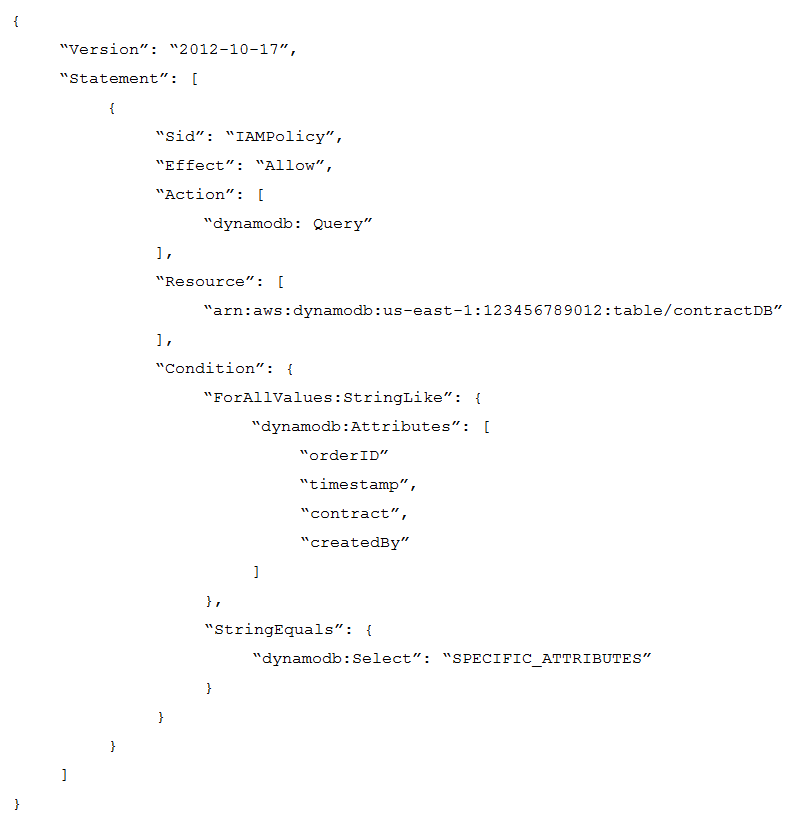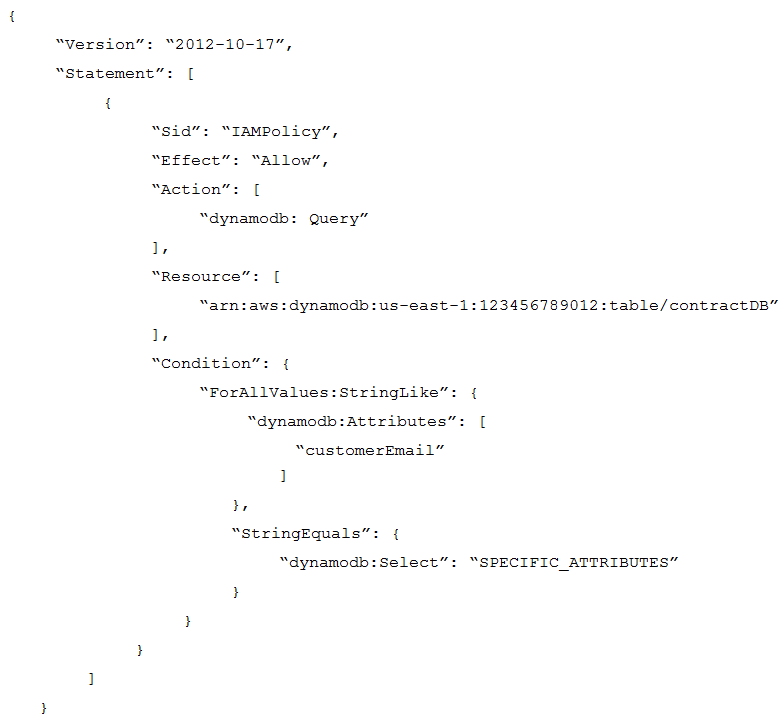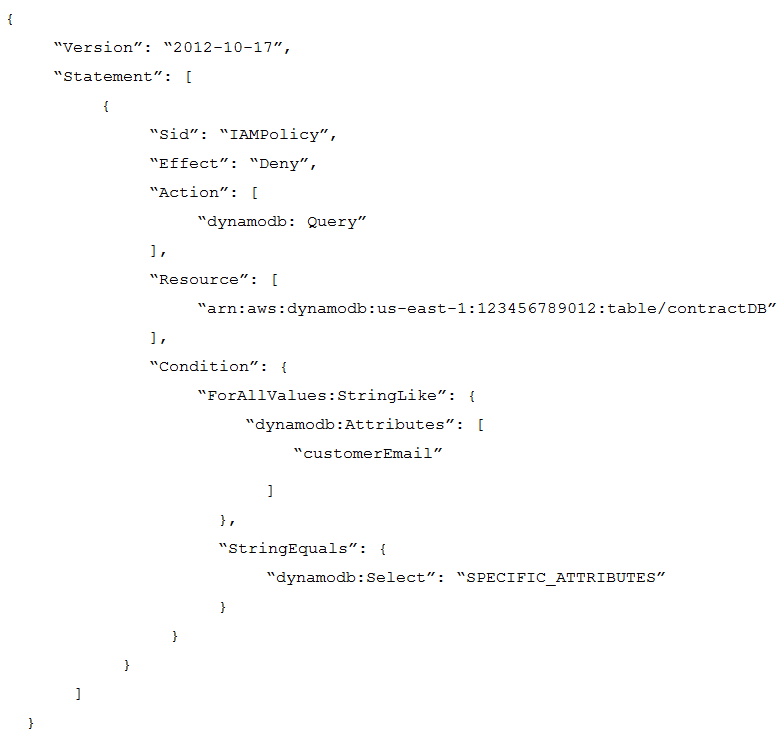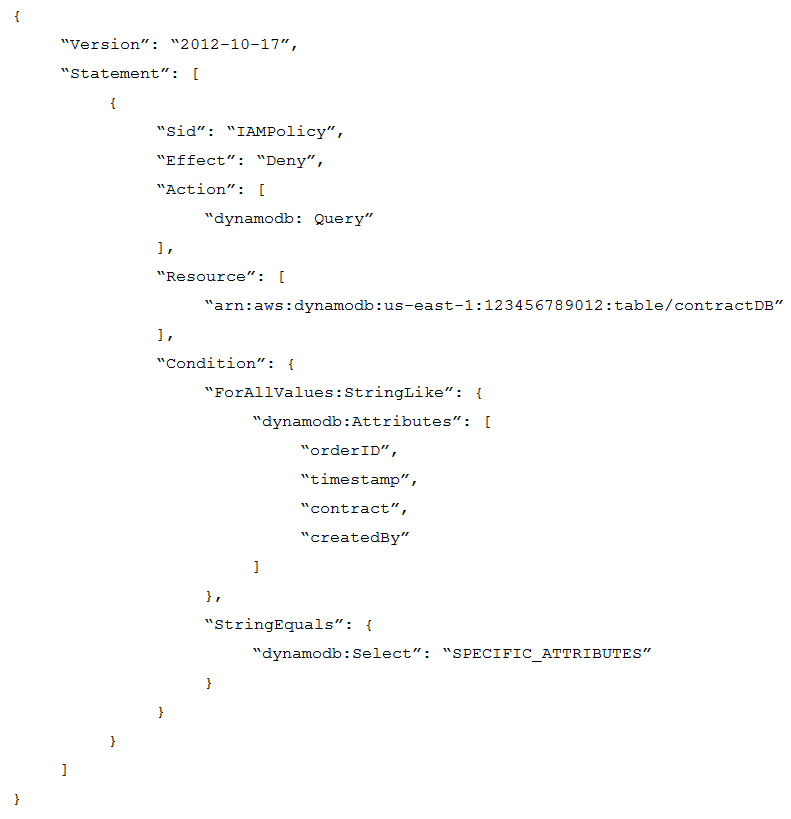A retail company manages a web application that stores data in an Amazon DynamoDB table. The company is undergoing account consolidation efforts. A database engineer needs to migrate the DynamoDB table from the current AWS account to a new AWS account.
Which strategy meets these requirements with the LEAST amount of administrative work?
C
A company uses the Amazon DynamoDB table contractDB in us-east-1 for its contract system with the following schema: orderID (primary key) timestamp (sort key) contract (map) createdBy (string) customerEmail (string)
After a problem in production, the operations team has asked a database specialist to provide an IAM policy to read items from the database to debug the application. In addition, the developer is not allowed to access the value of the customerEmail field to stay compliant.
Which IAM policy should the database specialist use to achieve these requirements?
A.
B.
C.
D.
A
A company has an application that uses an Amazon DynamoDB table to store user data. Every morning, a single-threaded process calls the DynamoDB API Scan operation to scan the entire table and generate a critical start-of-day report for management. A successful marketing campaign recently doubled the number of items in the table, and now the process takes too long to run and the report is not generated in time.
A database specialist needs to improve the performance of the process. The database specialist notes that, when the process is running, 15% of the table's provisioned read capacity units (RCUs) are being used.
What should the database specialist do?
B
A company is building a software as a service application. As part of the new user sign-on workflow, a Python script invokes the CreateTable operation using the
Amazon DynamoDB API. After the call returns, the script attempts to call PutItem.
Occasionally, the PutItem request fails with a ResourceNotFoundException error, which causes the workflow to fail. The development team has confirmed that the same table name is used in the two API calls.
How should a database specialist fix this issue?
D
Reference:
https://docs.aws.amazon.com/amazondynamodb/latest/APIReference/API_PutItem.html
To meet new data compliance requirements, a company needs to keep critical data durably stored and readily accessible for 7 years. Data that is more than 1 year old is considered archival data and must automatically be moved out of the Amazon Aurora MySQL DB cluster every week. On average, around 10 GB of new data is added to the database every month. A database specialist must choose the most operationally efficient solution to migrate the archival data to
Amazon S3.
Which solution meets these requirements?
C
A company developed a new application that is deployed on Amazon EC2 instances behind an Application Load Balancer. The EC2 instances use the security group named sg-application-servers. The company needs a database to store the data from the application and decides to use an Amazon RDS for MySQL DB instance. The DB instance is deployed in a private DB subnet.
What is the MOST restrictive configuration for the DB instance security group?
B
A company is moving its fraud detection application from on premises to the AWS Cloud and is using Amazon Neptune for data storage. The company has set up a 1 Gbps AWS Direct Connect connection to migrate 25 TB of fraud detection data from the on-premises data center to a Neptune DB instance. The company already has an Amazon S3 bucket and an S3 VPC endpoint, and 80% of the company's network bandwidth is available.
How should the company perform this data load?
C
A company migrated one of its business-critical database workloads to an Amazon Aurora Multi-AZ DB cluster. The company requires a very low RTO and needs to improve the application recovery time after database failovers.
Which approach meets these requirements?
D
A company is using an Amazon RDS for MySQL DB instance for its internal applications. A security audit shows that the DB instance is not encrypted at rest. The company's application team needs to encrypt the DB instance.
What should the team do to meet this requirement?
A
Reference:
https://docs.aws.amazon.com/AmazonRDS/latest/UserGuide/Overview.Encryption.html
A database specialist must create nightly backups of an Amazon DynamoDB table in a mission-critical workload as part of a disaster recovery strategy.
Which backup methodology should the database specialist use to MINIMIZE management overhead?
D
On-demand backup allows you to create full backups of your Amazon DynamoDB table for data archiving, helping you meet your corporate and governmental regulatory requirements. You can back up tables from a few megabytes to hundreds of terabytes of data, with no impact on performance and availability to your production applications. Backups process in seconds regardless of the size of your tables, so you do not have to worry about backup schedules or long-running processes. In addition, all backups are automatically encrypted, cataloged, easily discoverable, and retained until explicitly deleted.